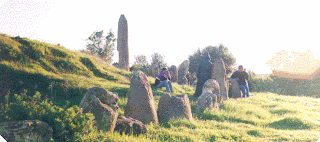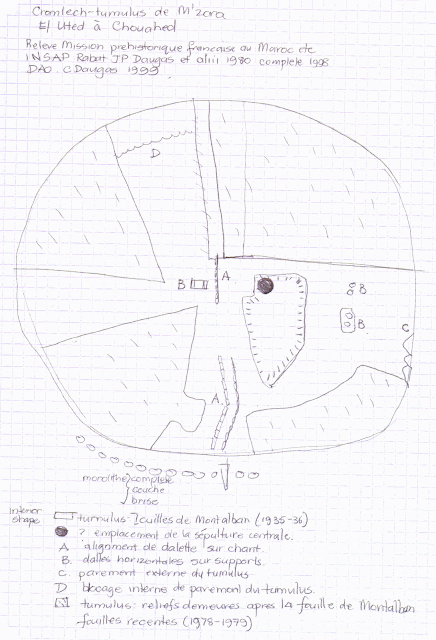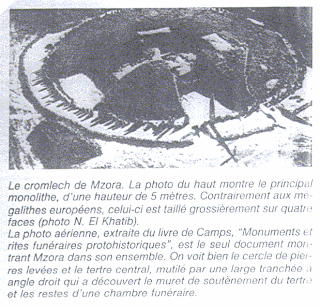 |
| Big stellae |
 |
Stones lying in the grass
|
When I was a student in Morocco, one of the things I wanted to see the most was the "Cromlech de Mzora", an ancient stone circle that was barely mentioned in the guidebooks, and unheard of by most Moroccans, so I undertook to do a research paper about it for my class there. The only information I found was in French texts (the names of which I also no longer have), and by renting a car to search it out in its tiny village. Unfortunately, the paper has been lost to the relics of no-internet backups, but I still have the photos I took, and the story of how it was to get there. I apologize to the people that quoted it in their academic papers and thank them enormously for the honor they did to quote me at all -- I will try and locate the paper one day and re-type it!
 |
| Whole mound and circle |
 |
| Biggest standing stone - El Uted "The Pointer" |
 |
| Bricks under the mound |
About half way between the small towns of Larache and Asilah, north of the Roman center called Lixus, the Arab village of Souq Tnine de Sidi el-Yamani is the closest place to the ruins. There are modern buildings and homes scattered right next to the ruins, and the stones themselves are in a bad state of disrepair. A small pond has formed inside the mound that was excavated by French scholars.
 |
| Edge of circle |
 |
Bilingual Stellae - image from a French text --
this is in a Museum and no longer at the site. |
 |
| View from the top |
 |
| Stones outside of circle |
 |
| Side view of circle |
 |
| Hunks out of stone - from afar |
While scattered, fallen and moved, the presence of 167 intact stones from the circle makes this impressive, as does the fact that you are free to wander freely among them. The state that the French Archaeologists left the site in is quite appalling, but its obscurity in Moroccan history books means that most Moroccans are uninterested in visiting it, so it does not see the same number of visitors that such a site would see in Europe, especially considering its size, and thus it is more preserved than it could be.
 |
| Entranceway |
 |
| Hunks out of stone - closeup view |
 |
| Copied diagram of Mzora from French text -- cited |
 |
| French text - inside tomb |


These two aerial photos were matched on the following google earth blog:
http://www.gearthblog.com/blog/archives/2011/01/hunting_for_the_megalithic_stone_ci.html

One French text I looked at shared this photo, but the surrounding area does not fit reality. The other photo below is more likely, however.
 |
| French textbook aerial photo |
 |
| Tombs south of Morocco |
 |
| North African monolithic sites |
Source: Lonely Planet Morocco, 6th Edition
Here's what the Lonely Planet says, and this was basically all I had to go on when I started my search:
"The ancient and little-understood Monoliths de M'Soura stand on a desolate patch of ground some 25km (by road) southeast of Asilah. The stones, arranged in a circle, range from 50cm to 6m in height and some historians believe the surround the tomb of a noble, perhaps dating back to Punic times. To get to the site you must first reach the village of Souq Tnine de Sidi el-Yamani, off highway P37, which branches east off the main Tangier to Rabat road. From here, 6km of bad piste (unsealed track) leads north to the site. You need a good vehicle, and a local guide would help."
















 These two aerial photos were matched on the following google earth blog: http://www.gearthblog.com/blog/archives/2011/01/hunting_for_the_megalithic_stone_ci.html
These two aerial photos were matched on the following google earth blog: http://www.gearthblog.com/blog/archives/2011/01/hunting_for_the_megalithic_stone_ci.html  One French text I looked at shared this photo, but the surrounding area does not fit reality. The other photo below is more likely, however.
One French text I looked at shared this photo, but the surrounding area does not fit reality. The other photo below is more likely, however.



wow, this is so amazing and shocking at the same time! i'm from Morocco, and seeing/reading this for the first time would be like an English person hearing for the first time about the majestic Stonehenge. Why didn't i know about this before i had to look it up for an upcoming exam? I asked myself. It is true, most Moroccans do not know their own history, let alone ancient history, which is more enchanting to me. I applaud your work :)
ReplyDeleteThanks for your appreciative comment! Before I lived in Morocco I had never heard of it, and I think that most people in Morocco don't know it's there. Great to hear your teacher asked you to look it up for an exam!
ReplyDeleteNatalya, The French did not excavate Msoura, in 1935-36 a Spanish archaeologist, Cesar Louis de Montalban, had 6 m deep trenches dug through the tumulus. He recorded nothing about his graverobbery. was arrested during the Spanish Civil war. Vandalism attracts more vandalism, and local followers of Islam drilled holes in the standing stones and broke them. You show pictures of Gavrinis in Brittany, and of the Avebury henge in England, which you confuse with Msoura. (the Holy Place).
ReplyDeleteHi John. Apologies that I'm only seeing your comment now -- my blog was beleaguered by spam comments and so I missed some of the real ones. It was 1999/2000 when I did my research and collected the photos and information, and unfortunately, I have lost the names of any text sources I used. I know I struggled to find any information at all on it at the time, so thank you for the information. The photo errors you mention are the aerial photos, I assume, which as you can see from what I wrote, I also doubted belonged to Mzoura. Thanks for clarifying where they are. Please do get in touch as I would be interested in hearing about your connection to the site.
Delete